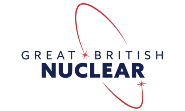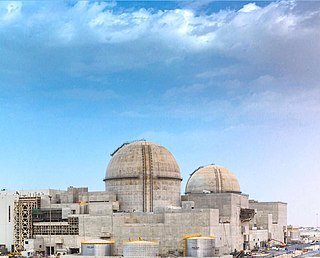
Sellafield, formerly known as Windscale, is a large multi-function nuclear site close to Seascale on the coast of Cumbria, England. As of August 2022, primary activities are nuclear waste processing and storage and nuclear decommissioning. Former activities included nuclear power generation from 1956 to 2003, and nuclear fuel reprocessing from 1952 to 2022.
Westinghouse Electric Company LLC is an American nuclear power company formed in 1999 from the nuclear power division of the original Westinghouse Electric Corporation. It offers nuclear products and services to utilities internationally, including nuclear fuel, service and maintenance, instrumentation, control and design of nuclear power plants. Westinghouse's world headquarters are located in the Pittsburgh suburb of Cranberry Township, Pennsylvania.

Great British Nuclear (GBN), formerly British Nuclear Fuels Ltd (BNFL), is a nuclear energy and fuels company owned by the UK Government. It is a non-departmental public body sponsored by the Department for Energy Security and Net Zero.

Wylfa nuclear power station is a Magnox nuclear power station undergoing decommissioning. Wylfa is situated west of Cemaes Bay on the island of Anglesey, off the northwestern coast of Wales. Construction of the two 490 MW nuclear reactors, known as Reactor 1 and Reactor 2, began in 1963. They became operational in 1971. Wylfa was located on the coast because seawater was used as a coolant.

The EPR is a Generation III+ pressurised water reactor design. It has been designed and developed mainly by Framatome and Électricité de France (EDF) in France, and by Siemens in Germany. In Europe this reactor design was called European Pressurised Reactor, and the internationalised name was Evolutionary Power Reactor, but is now simply named EPR.

The Virgil C. Summer Nuclear Power Station occupies a site near Jenkinsville, South Carolina, in Fairfield County, South Carolina, approximately 20 miles (32 km) northwest of Columbia.
The "Nuclear Power 2010 Program" was launched in 2002 by President George W. Bush in 2002, 13 months after the beginning of his presidency, in order to restart orders for nuclear power reactors in the U.S. by providing subsidies for a handful of Generation III+ demonstration plants. The expectation was that these plants would come online by 2010, but it was not met.

The AP1000 is a nuclear power plant designed and sold by Westinghouse Electric Company. The plant is a pressurized water reactor with improved use of passive nuclear safety and many design features intended to lower its capital cost and improve its economics.
Nuclear power in the United Kingdom generated 16.1% of the country's electricity in 2020. As of August 2022, the UK has 9 operational nuclear reactors at five locations, producing 5.9 GWe. It also has nuclear reprocessing plants at Sellafield and the Tails Management Facility (TMF) operated by Urenco in Capenhurst.
Korea Electric Power Corporation, better known as KEPCO (Korean: 켑코) or Hanjeon (Korean: 한전), is the largest electric utility in South Korea, responsible for the generation, transmission and distribution of electricity and the development of electric power projects including those in nuclear power, wind power and coal. KEPCO, through its subsidiaries, is responsible for 93% of Korea's electricity generation as of 2011. The South Korean government owns a 51.11% share of KEPCO. Together with its affiliates and subsidiaries, KEPCO has an installed capacity of 65,383 MW. On the 2011 Fortune Global 500 ranking of the world's largest companies, KEPCO was ranked 271. KEPCO is a member of the World Energy Council, the World Nuclear Association and the World Association of Nuclear Operators. As of August 2011, KEPCO possesses an A+ credit rating with Fitch Ratings, while Moody's has assigned KEPCO an A1 stable rating.

The Khmelnytskyi Nuclear Power Plant generates nuclear power in Ukraine. The plant is operated by Energoatom. Two VVER-1000 reactors are operational, each generating 1000 MW (net) of electricity, with two AP1000 reactors under construction.

NuScale Power Corporation is a publicly traded American company that designs and markets small modular reactors (SMRs). It is headquartered in Portland, Oregon. A 50 MWe version of the design was certified by the US Nuclear Regulatory Commission (NRC) in January 2023. The current scalable 77 MWe SMR VOYGR design was submitted for NRC review on January 1, 2023, and as of December 2023 was about a third complete.

Horizon Nuclear Power is a British energy company that was expected to build new nuclear power stations in the United Kingdom. It was established in 2009, with its head office in Gloucester, and is now owned by Hitachi.
The Office for Nuclear Regulation (ONR) is the regulator for the nuclear industry in the United Kingdom. It is an independent statutory corporation whose costs are met by charging fees to the nuclear industry. The ONR reports to the Department for Work and Pensions, although it also worked closely with the now-defunct Department of Energy and Climate Change.

The APR-1400 is an advanced pressurized water nuclear reactor designed by the Korea Electric Power Corporation (KEPCO). Originally known as the Korean Next Generation Reactor (KNGR), this Generation III reactor was developed from the earlier OPR-1000 design and also incorporates features from the US Combustion Engineering (C-E) System 80+ design. Currently in South Korea there are 4 units in operation, and 2 units in construction. Four units are completed and in commercial operation in the United Arab Emirates at Barakah.
Moorside nuclear power station is proposed for a site near Sellafield, in Cumbria, England. The original plan by NuGeneration, a British subsidiary of Toshiba-owned Westinghouse Electric Company, had the station coming online from 2024 with 3.4 GW of new nuclear capacity, from three AP1000 reactors. Work up to 2018 would include acquiring the site licence, the development consent order, and other required permits and permissions to start work. Site preparation was to take two years, up to 2020.

The Hualong One is a Chinese Generation III pressurized water nuclear reactor jointly developed by the China General Nuclear Power Group (CGN) and the China National Nuclear Corporation (CNNC). The CGN version, and its derived export version, is called HPR1000. It is commonly mistakenly referred to in media as the "ACPR1000" and "ACP1000", which are in fact earlier reactors design programs by CGN and CNNC.
Shidao Bay Nuclear Power Plant, commonly known as Shidaowan, is a nuclear power plant in Shandong province, China. The site is located near the Xiqianjia village in Ningjin subdistrict, Rongcheng, Weihai, Shandong. The plant is located about 23 kilometres (14 mi) south of Rongcheng City, 14 kilometres (8.7 mi) northwest of Shidao, and 68 kilometres (42 mi) southeast of Weihai City.











